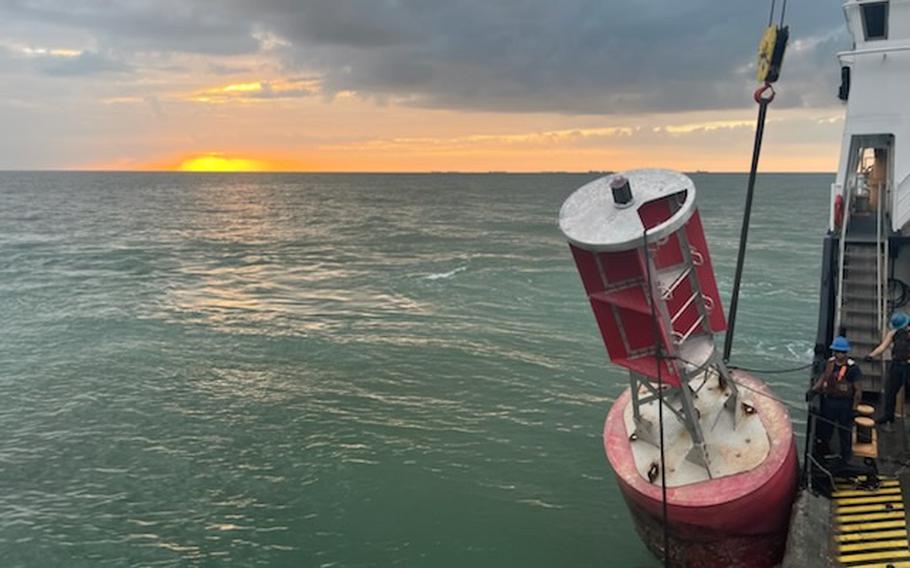
U.S. Coast Guard Cutter Joshua Appleby (WLM 556) personnel work buoys in Tampa Bay after they were set off-station by Hurricane Milton, Oct. 11, 2024. (Richard Keefauver/U.S. Coast Guard)
BOSTON (Tribune News Service) — The Coast Guard’s plan to remove hundreds of navigation buoys along the Northeast coastline is raising concerns among commercial fishermen and other mariners who depend on the markers to avoid rocks, fog and other dangers on the water.
The plan calls for removing 350 of the 4,700 navigational buoys in waters from New York to the Canadian border. Over the next five years, up to 1,000 buoys could be removed from the water, the agency said.
Matthew Stuck, the Coast Guard’s first district chief of waterways management, said the project, which has been in the works for about two years, is meant to “rightsize” the number of navigation buoys on the water, and will improve waterway safety “by ensuring the right short-range aids work well with modern navigation technology.”
“We’re actively adjusting short-range aids to work better and more sustainably given today’s navigation tools and methods,” Stuck said in a prepared statement. “A sustainable buoy system ensures safety and efficiency, even during disruptions or technology failures, keeping commerce flowing smoothly.”
Nearly every commercial and recreational boat has a GPS and other electronic navigation, and the new technology allows officials to rethink how many buoys need to be in the water. There is no timeline yet for removing the buoys, but the agency wants to hear from boaters about the plans, he said.
‘Essential tools’
But the plan is raising safety concerns, especially among commercial fishermen, who say reducing the number of buoys means boaters would have to rely solely on electronic navigational systems to navigate harbors and avoid rocky ledges under the surface of the water.
“Any reduction in aids to navigation is of great concern to the fishing industry,” said Beth Casoni, executive director of the Massachusetts Lobsterman’s Association, which is expected to discuss the issue at its meeting next Wednesday.
The Maine Lobstermen’s Association is already urging the Coast Guard to reconsider its plans, saying the buoys are “essential” makers to avoid hazards on the water.
In a statement, the association said it is concerned about the plan “because these buoys are not just markers, they are essential tools that help ensure the safety of everyone who works or recreates on the water.”
“They are especially critical in areas prone to dense fog, strong currents, or hidden hazards,” the trade group said. “Their removal could jeopardize the safety of those who depend on them daily and we urge the Coast Guard to reconsider.”
This shift towards electronic navigation is intended to identify Aids to Navigation that may be considered less critical for navigational safety. The underlying concept is a move away from reliance on physical buoys towards electronic methods, which inherently increases a mariner’s dependence on electronic systems.
Gloucester Harbormaster Chris Lucido is “strongly” urging boaters to provide feedback to the Coast Guard about the plans. He, too, is concerned about reducing the number of physical navigational aids.
“These aids provide a crucial sense of reassurance regarding a vessel’s proximity to underwater hazards such as ledges and rock piles, as well as indicating the vessel’s position within a marked navigational channel,” he wrote in a letter to boaters about the plan.
“The ability to physically verify one’s location using an Aid to Navigation remains an invaluable safety measure.”
He said the shift away from a reliance on physical buoys towards electronic methods “inherently increases a mariner’s dependence on electronic systems.”
“While electronic navigation is undoubtedly a valuable tool, fundamental principles of good seamanship and navigation emphasize avoiding sole reliance on one system,” Lucido wrote.
Stuck said regardless of technological advances, “a robust physical aids to navigation network will always complement electronic systems.”
“This effort will result in the most sustainable navigation risk reduction to support and complement modern mariners, and today’s much larger ships,” the Coast Guard said. “Electronic Charting System availability and requirements, and powerful smartphone navigation subscription apps are affordably accessible to virtually all waterway users.”
State Senate Minority Leader Bruce Tarr is urging the Coast Guard to conduct a thorough review of the buoy removal plans. He said buoys are “a tried-and-true tool to guide navigation” and must “continue to play a fundamental role in marine safety.”
“While new electronic technology is being increasingly used by mariners on vessels of all types and sizes, that doesn’t render buoys obsolete,” the Gloucester Republican said.
“Reducing their number should be carefully considered before any such action is taken.”
The Coast Guard is soliciting feedback from mariners on the proposal by June 13 at DPWPublicComments@uscg.mil.
© 2025 the Gloucester Daily Times (Gloucester, Mass.).
Visit www.gloucestertimes.com.
Distributed by Tribune Content Agency, LLC.